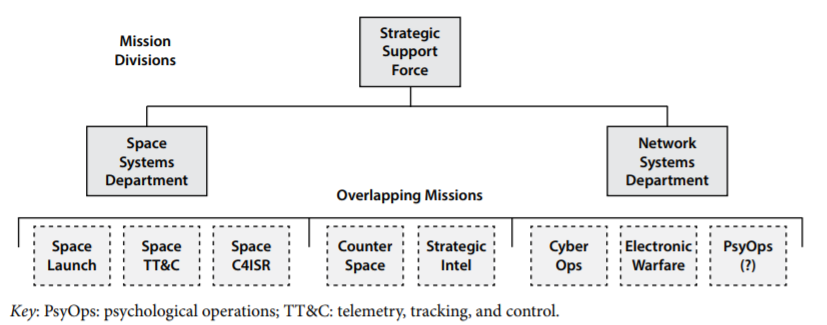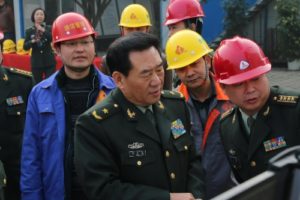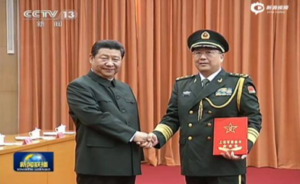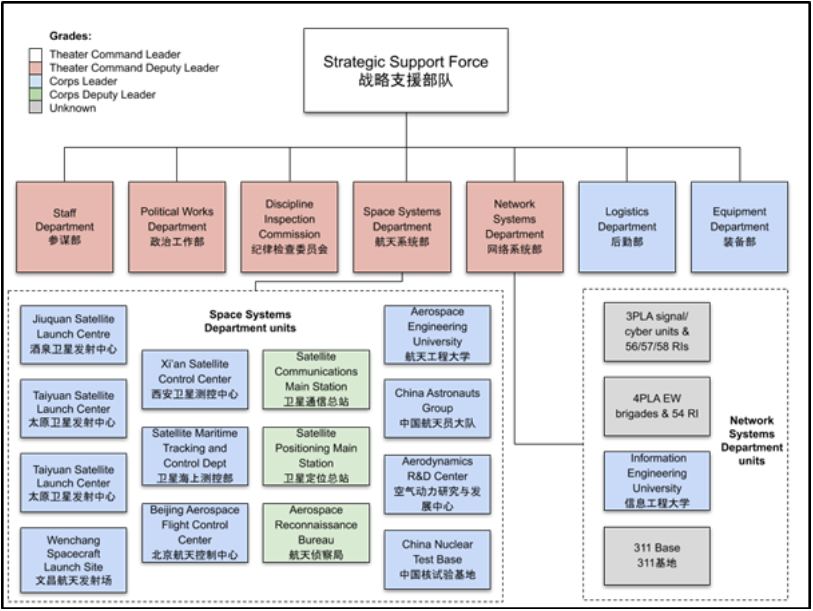By: Adam Ni, Bates Gill
Introduction
China established the People’s Liberation Army (PLA) Strategic Support Force (SSF) (zhanlue zhiyuan budui, 战略支援部队) in late 2015 as part of a sweeping military reform that overhauled the PLA’s organizational structure, command and control systems, and operational paradigm. At its core, the reform aimed to improve the PLA’s ability to fight informationized conflicts (xinxihua zhanzheng, 信息化战争), and enhance joint operations and power projection capabilities in support of China’s strategic aims (Xinhua, January 1, 2016).
In the three and half years since the creation of the SSF, a trickle of Chinese language sources has allowed foreign analysts to piece together a coherent, albeit incomplete, picture of this young but opaque organization (China Brief, February 8, 2016; China Brief, December 26, 2016; RAND, November 10, 2017; Cyber Defense Review, July 31, 2018; Project 2049 Institute, September 25, 2018;NDU, October 2, 2018). This article aims to provide an up-to-date outline of the SSF’s missions, leadership, and organizational structure. Note that the SSF is still in the process of consolidating, reorganizing and integrating the assorted capabilities and organizations that have fallen under its banner. This extensive effort will likely take years to complete.
Official Characterizations of the SSF
Despite the apparent importance of the SSF, official characterizations have been somewhat vague. According to China’s Ministry of National Defense spokesperson Senior Colonel Yang Yujun (杨宇军):
“The Strategic Support Force is a new-type combat force for safeguarding national security. It is an important growth point of the military’s new combat capability. It is mainly formed from the functional integration of various types of support forces with strong strategic, foundational and supportive functions. The establishment of the Strategic Support Force is conducive for optimizing the military’s force structure and improving integrated support capabilities. [The PLA] will persist with system integration, military-civilian integration, the construction of new combat forces, and will strive to build a strong and modern strategic support force.” (MND, January 1, 2016)
The PLA’s concept of “new-type combat force” (xinxing zuozhan liliang, 新型作战力量) is noteworthy because it concisely encapsulates the raison d’être of the SSF. One PLA source describes it as a “product of developments in military technology and the evolution of warfare”–one centered on leveraging space, electromagnetic, and network capabilities as key enablers of integrated joint operations across multiple domains of conflict, including land, sea, air, space and network domains (PLA Daily, June 10, 2015). Indeed, the 2013 edition of the Science of Military Strategypublished by the PLA Academy of Military Science calls for prioritizing the development of “new-type combat forces” with respect to “near space, outer space and network space” that are “able to surpass geographical barriers and directly threaten the center of gravity and key nodes of an enemy’s combat systems” (AMS, December, 2013).
Another aspect worth highlighting is the critical role of the SSF in enabling joint operations. The SSF aspires to be the PLA’s “information umbrella” (xinxi san, 信息伞), integrated throughout the full cycle of land, sea, air and missile force operations, from start to finish (People.cn, January 24, 2016).
Missions and Drivers
The SSF, as the new information warfare force of the PLA, has two primary missions. First, it is to provide the PLA with strategic information support through space and network-based capabilities, including communications, navigation and positioning, intelligence, surveillance and reconnaissance, and the protection of military information infrastructure. Second, the SSF is to conduct information operations, including space and counterspace, cyber, electromagnetic warfare, and psychological operations.
Another way of understanding SSF missions is to consider the division of labor between the organization’s space and network forces (see graph below). It is important to note that there are overlapping missions, including counter-space and strategic intelligence. (Source: NDU, October 2, 2018)
(Source: NDU, October 2, 2018)
 (Source: NDU, October 2, 2018)
(Source: NDU, October 2, 2018)
The main driver for the creation of the SSF is the desire to consolidate most of the PLA’s information warfare capabilities within one organization in order to facilitate integrated information support and operations, enhance coordination, and achieve efficiency gains. Seen from a bureaucratic angle, the SSF is the inheritor of much of the PLA’s information capabilities that were housed in the former four general headquarters, and especially in the General Staff Department (GSD) and General Armaments Department (GAD), all of which were dissolved in the reorganization announced in December 2015.
The creation of the SSF clearly signals the importance of information dominance for China’s military planners. It is also a direct recognition that the “strategic frontiers” (zhanlue bianjiang, 战略边疆) of space and cyberspace are vital to China’s expanding hard power as well as its broader strategic interests, including economic growth and technological development. [1]
Leadership of the Strategic Support Force
In the PLA hierarchy, the grade of a person or organization determines their relative seniority. Generally, each grade level has two ranks assigned to it. For example, a Theater Command Leader grade position can be assigned to either a General (shang jiang, 上将) or a Lieutenant General (zhong jiang, 中将). [2] As the table below shows, the senior leadership of the SSF consists of two Theater Command Leader (zheng zhanqu zhi, 正战区职) grade officers, and at least seven Theater Command Deputy Leader (fu zhanqu zhi, 副战区职) grade officers [3]. The SSF Commander and Political Commissar are both supported by three deputies, respectively.
Lieutenant General Li Fengbiao (李凤彪, b. 1959) succeeded the first SSF Commander, General Gao Jin (高津), in March 2019 (CCTV, May 8; Mingpao, May, 6). His past roles include: Deputy Commander and Chief of Staff, Central Theater Command (2016-2019); Deputy Commander, Chengdu Military Region (2014-2016); and Commander, 15th Airborne Corps (2011-2014) (The Paper, February 4, 2016; Sohu, January 1, 2015; Global Times, July 7, 2015). He has spent most of his 40-year military career in the PLA Air Force Airborne Corps.
General Zheng Weiping (郑卫平, b. 1955) has been the SSF Political Commissar since mid-2017 (Caixin, October 22, 2017; Phoenix Net, November 3, 2917). He replaced the first SSF Political Commissar, General Liu Fulian (刘福连). General Zheng’s past roles include: Political Commissar, Eastern Theater Command (2016-2017); Political Commissar, Nanjing Military Region (2012-2016); and Director, Political Department, Guangzhou Military Region (2007-2012) (Baidu Baike, July 11, 2018).
Lieutenant General Rao Kaixun (饶开勋, b. 1964) has served as an SSF Deputy Commander since January 2016 (The Paper, March 11, 2016). Although unconfirmed, we assess that he is also its current Chief of Staff. His past roles include: Director, General Staff Department Operations Department (2013-2015); Commander, 14th (now 75th) Group Army; and Chief of Staff, 13th (now 77th) Group Army (2010-2012) (Baidu Baike, May 10, 2018; Project 2049 Institute, September 25, 2018).
Lieutenant General Lu Jiancheng (吕建成, b. 1956) has served as a SSF Deputy Political Commissar and Secretary of its Discipline Inspection Commission since 2016 (The Paper, September 27, 2016). His past roles include: Deputy Political Commissar, Jinan Military Region (2009-2016); Political Commissar, People’s Armed Police Chongqing Command; and Political Commissar, People’s Armed Police Gold Force Command (The Paper, June 7, 2016; Baidu Baike, August 15, 2018).
Lieutenant General Feng Jianhua (冯建华, b. 1958) has served as the Director of SSF’s Political Work Department since January 2016. His past roles include: Deputy Director, GAD Political Department; and Director, GPD Cadre Department (The Paper, February 28, 2016).
Lieutenant General Shang Hong (尚宏, b. 1960) has served as a SSF Deputy Commander and Director of its Space Systems Department since 2016. His past roles include: Deputy Director, GAD (2015); Chief of Staff, GAD (2011-2015); and Director, Jiuquan Satellite Launch Center (2013-2016) (Caixin, October 19, 2017; Baidu Baike, May 10, 2018; Project 2049 Institute, September 25, 2018).
Lieutenant General Kang Chunyuan (康春元, b. 1958) has served as a SSF Deputy Political Commissar, and the Political Commissar of the SSF Space Systems Department since 2016 (Caixin, August 29, 2016). His past roles include: Deputy Political Commissar, Lanzhou Military Region (2014-2015); and Deputy Director, Political Department, Beijing Military Region (2010-2014) (Baidu Baike, July 2, 2018).
Lieutenant General Zheng Junjie (郑俊杰, b. 1957) has served as a SSF Deputy Commander and Director of its Network Systems Department since 2016. His past roles include: President, PLA Information Engineering University (2013-2015); Deputy Director, GSD Technical Reconnaissance Department (2015) (Tencent, March 10, 2018; The Paper, May 6, 2015).
Lieutenant General Chai Shaoliang (柴绍良, b. 1954) probably has served as a Deputy Political Commissar, and and the Political Commissar of the SSF Space Systems Department since 2016 (NPC, February, 2018). His past roles include: Deputy Political Commissar, GAD (2014-2015); Deputy Political Commissar, Chengdu Military Region (until 2014); Director, Political Department, Chengdu Military Region (from 2011); and Director, GPD Organization Department (2009-2011) (Baidu Baike, March 13).
 Images: Senior officers of the SSF in previous roles. Top: Then-Deputy Commander of the Sichuan Military Region Li Fengbiao (center) inspects the construction site of a military hospital in 2015. (Source: CECEP.cn) Bottom: Then-Political Commissar for the Nanjing Military Region Zheng Weiping is congratulated by CCP General Secretary Xi Jinping at a 2015 ceremony marking Zheng’s promotion to full General. (Source: CCTV)
Images: Senior officers of the SSF in previous roles. Top: Then-Deputy Commander of the Sichuan Military Region Li Fengbiao (center) inspects the construction site of a military hospital in 2015. (Source: CECEP.cn) Bottom: Then-Political Commissar for the Nanjing Military Region Zheng Weiping is congratulated by CCP General Secretary Xi Jinping at a 2015 ceremony marking Zheng’s promotion to full General. (Source: CCTV)
Organizational Structure and Composition

At the top of SSF’s organizational structure stand six 1st-level departments (four administrative and two operational) and the Discipline Inspection Commission. The anomaly in the SSF structure is that the two operational departments – the Space Systems Department (SSD) and the Network Systems Department (NSD) – are at the same grade (Theater Command Deputy Leader) as the Staff Department. This means that they are likely to report directly to the SSF headquarters instead of the Staff Department.
Administrative Organs
The Staff Department (Canmou Bu, 参谋部) is responsible for operations and planning, training, project management and oversight, and personnel management. Four subordinate bureaus have been identified: the Operational Planning Bureau (Zhanqin Jihua Ju, 战勤计划局), the Training Bureau (Xunlian Ju, 训练局), the Direct Subordinate Works Bureau (Zhishu Gongzuo Ju, 直属工作局), and the Navigation Bureau (Daohang Ju, 导航局) (National Health Commission, September 7, 2018; Xi’an Jiaotong University, May 29, 2018; Eastern Headlines, September 22, 2016).
The other top-tier administrative organs include the Political Works Department (Zhengzhi Gongzuo Bu, 政治工作部), the Discipline and Inspection Commission (Jilu Jiancha Weiyuanhui, 纪律检查委员会), the Logistics Department (Houqin Bu, 后勤部), and the Equipment Department (Zhuangbei Bu, 装备部) (Sina, June 26, 2018; Chaoyang Daily, July 27, 2018; Sina, March 10; Project 2049 Institute, September 25, 2018; jsccexpo, 2018/2019).
Space Systems Department (SSD)
The SSD is responsible for executing the SSF’s space mission. The SSD has consolidated nearly every aspect of China’s military space operations, including space launch, telemetry, tracking, and control (TT&C), satellite communications, space intelligence, surveillance, and reconnaissance (ISR), and space-related R&D and support. They also appear to have administrative responsibilities for China’s astronauts. Before the reform of 2015/2016, these space-related responsibilities were held under the GAD, and to a lesser extent, the GSD.
The tables below outlines SSF SSD’s subordinate organizations according to their functions.
Space Launch Facilities
No comments:
Post a Comment